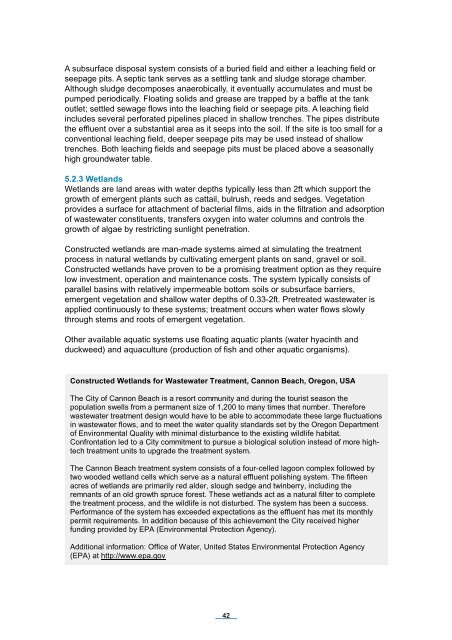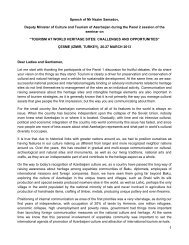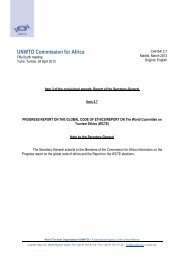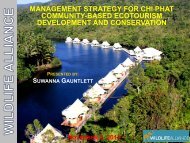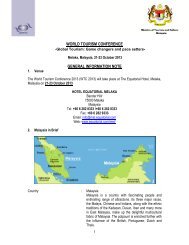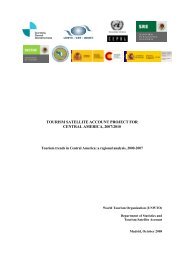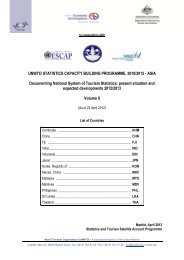A Manual for Water and Waste Management - World Tourism ...
A Manual for Water and Waste Management - World Tourism ...
A Manual for Water and Waste Management - World Tourism ...
You also want an ePaper? Increase the reach of your titles
YUMPU automatically turns print PDFs into web optimized ePapers that Google loves.
A subsurface disposal system consists of a buried field <strong>and</strong> either a leaching field or<br />
seepage pits. A septic tank serves as a settling tank <strong>and</strong> sludge storage chamber.<br />
Although sludge decomposes anaerobically, it eventually accumulates <strong>and</strong> must be<br />
pumped periodically. Floating solids <strong>and</strong> grease are trapped by a baffle at the tank<br />
outlet; settled sewage flows into the leaching field or seepage pits. A leaching field<br />
includes several per<strong>for</strong>ated pipelines placed in shallow trenches. The pipes distribute<br />
the effluent over a substantial area as it seeps into the soil. If the site is too small <strong>for</strong> a<br />
conventional leaching field, deeper seepage pits may be used instead of shallow<br />
trenches. Both leaching fields <strong>and</strong> seepage pits must be placed above a seasonally<br />
high groundwater table.<br />
5.2.3 Wetl<strong>and</strong>s<br />
Wetl<strong>and</strong>s are l<strong>and</strong> areas with water depths typically less than 2ft which support the<br />
growth of emergent plants such as cattail, bulrush, reeds <strong>and</strong> sedges. Vegetation<br />
provides a surface <strong>for</strong> attachment of bacterial films, aids in the filtration <strong>and</strong> adsorption<br />
of wastewater constituents, transfers oxygen into water columns <strong>and</strong> controls the<br />
growth of algae by restricting sunlight penetration.<br />
Constructed wetl<strong>and</strong>s are man-made systems aimed at simulating the treatment<br />
process in natural wetl<strong>and</strong>s by cultivating emergent plants on s<strong>and</strong>, gravel or soil.<br />
Constructed wetl<strong>and</strong>s have proven to be a promising treatment option as they require<br />
low investment, operation <strong>and</strong> maintenance costs. The system typically consists of<br />
parallel basins with relatively impermeable bottom soils or subsurface barriers,<br />
emergent vegetation <strong>and</strong> shallow water depths of 0.33-2ft. Pretreated wastewater is<br />
applied continuously to these systems; treatment occurs when water flows slowly<br />
through stems <strong>and</strong> roots of emergent vegetation.<br />
Other available aquatic systems use floating aquatic plants (water hyacinth <strong>and</strong><br />
duckweed) <strong>and</strong> aquaculture (production of fish <strong>and</strong> other aquatic organisms).<br />
Constructed Wetl<strong>and</strong>s <strong>for</strong> <strong>Waste</strong>water Treatment, Cannon Beach, Oregon, USA<br />
The City of Cannon Beach is a resort community <strong>and</strong> during the tourist season the<br />
population swells from a permanent size of 1,200 to many times that number. There<strong>for</strong>e<br />
wastewater treatment design would have to be able to accommodate these large fluctuations<br />
in wastewater flows, <strong>and</strong> to meet the water quality st<strong>and</strong>ards set by the Oregon Department<br />
of Environmental Quality with minimal disturbance to the existing wildlife habitat.<br />
Confrontation led to a City commitment to pursue a biological solution instead of more hightech<br />
treatment units to upgrade the treatment system.<br />
The Cannon Beach treatment system consists of a four-celled lagoon complex followed by<br />
two wooded wetl<strong>and</strong> cells which serve as a natural effluent polishing system. The fifteen<br />
acres of wetl<strong>and</strong>s are primarily red alder, slough sedge <strong>and</strong> twinberry, including the<br />
remnants of an old growth spruce <strong>for</strong>est. These wetl<strong>and</strong>s act as a natural filter to complete<br />
the treatment process, <strong>and</strong> the wildlife is not disturbed. The system has been a success.<br />
Per<strong>for</strong>mance of the system has exceeded expectations as the effluent has met its monthly<br />
permit requirements. In addition because of this achievement the City received higher<br />
funding provided by EPA (Environmental Protection Agency).<br />
Additional in<strong>for</strong>mation: Office of <strong>Water</strong>, United States Environmental Protection Agency<br />
(EPA) at http://www.epa.gov<br />
42


